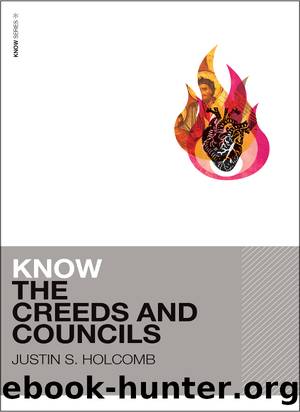Know the Creeds and Councils by Justin S. Holcomb

Author:Justin S. Holcomb [Holcomb, Justin S.]
Language: eng
Format: epub
Publisher: Zondervan
Published: 2017-10-02T00:00:00+00:00
A copy of the Decrees and Canons of the Council of Trent can be found at http://history.hanover.edu/texts/trent.xhtml.
CHAPTER 9
HEIDELBERG CATECHISM
1563
Historical Background
By the middle of the sixteenth century, several different strands of the Protestant Reformation had begun spreading like wildfire across the European continent. The diversity within Protestantism proved to be a double-edged sword. Unlike Roman Catholicism, which had established a solid core of beliefs at the Council of Trent, Protestants were only loosely bound together by the five famous âsolasâ â from the Latin word sola, meaning âaloneâ or âonly.â The five solas are five phrases or slogans that emerged during the Protestant Reformation and that summarize the Reformersâ basic theological convictions that the Reformers believed to be essentials of the Christian life and practice. The five solas are:
1. Sola Scriptura (âScripture aloneâ): Scripture alone is our highest authority.
2. Sola Fide (âfaith aloneâ): we are saved by grace alone, through faith alone.
3. Sola Gratia (âgrace aloneâ): we are saved by grace alone, through faith alone.
4. Solus Christus (âChrist aloneâ): Christ alone is our Lord, Savior, and King, and the only mediator between God and humanity.
5. Soli Deo Gloria (âglory to God aloneâ): we live for the glory of God alone.
These basic beliefs emerged in the Protestant effort to distinguish itself from the teaching of the Roman Catholic Church. On a positive note, this allowed the movement to gain traction quickly in a variety of different contexts and locations, but unfortunately it also meant that disputes and disagreements frequently arose between the different branches of the newfound Protestantism.
Disagreement between the Lutheran and Zwinglian (a group of Protestants founded by Swiss Reformer Ulrich Zwingli) factions was particularly intense. One pointed conflict broke out in Heidelberg under the rule of Otto Heinrich (1556 â 59) concerning Christâs presence in the Lordâs Supper. The Lutherans believed that Christâs body is really present in the bread and wine in the same way that heat permeates an iron placed in a hot fire. In contrast, the Zwinglians believed that the Lordâs Supper is primarily a symbolic service of remembrance. Since Christâs body is at the right hand of the Father in heaven, the Zwinglians found it hard to believe that Christâs body could be a real human body and somehow be present both in heaven and in the bread and the wine. (The Calvinists, by contrast, held a third position: they maintained that Christ is present not in body but in Spirit.) One staunch Lutheran fought for making Lutheranism the official religion of the city, and he even went so far as to excommunicate a Zwinglian deacon after getting into a fight over the communion cup with the deacon at the altar.
Because politics and religion were closely related in pre-Enlightenment Europe, it was difficult to just âagree to disagree.â So when Frederick III succeeded Otto Heinrich in ruling the city of Heidelberg, he charged the theology faculty to develop a new catechism to lay to rest the often-heated debates over the Lordâs Supper and at the same
Download
This site does not store any files on its server. We only index and link to content provided by other sites. Please contact the content providers to delete copyright contents if any and email us, we'll remove relevant links or contents immediately.
| Book of Common Prayer | Catechisms |
| Devotionals | Hymns & Hymnals |
| Meditations | Monasticism & Asceticism |
| Pentecostal & Charismatic | Prayerbooks |
| Rites & Ceremonies | Sacraments |
More Language of Letting Go: 366 New Daily Meditations by Melody Beattie(2966)
The Secret Power of Speaking God's Word by Joyce Meyer(2964)
To Light a Sacred Flame by Silver RavenWolf(2767)
How Proust Can Change Your Life by Alain De Botton(2741)
Anxious for Nothing by Max Lucado(1907)
A TIME TO KEEP SILENCE by Patrick Leigh Fermor(1862)
Curse Tablets and Binding Spells from the Ancient World by Gager John G.;(1836)
The Gnostic Gospel of St. Thomas by Tau Malachi(1736)
7 Secrets of Divine Mercy by Vinny Flynn(1688)
all by Unknown Author(1630)
365 Tao: Daily Meditations by Ming-Dao Deng(1587)
From Good Goddess to Vestal Virgins: Sex and Category in Roman Religion by Ariadne Staples(1543)
100 Days of Thanks by Thomas Nelson(1523)
To Ride a Silver Broomstick by Silver RavenWolf(1523)
Anam Cara by John O'Donohue(1511)
The Fasting Edge by Jentezen Franklin(1506)
To Stir a Magick Cauldron by Silver RavenWolf(1492)
The Sacred Enneagram by Christopher L. Heuertz(1409)
New Morning Mercies by Paul David Tripp(1364)
